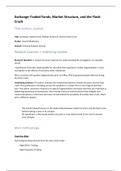Samenvatting
Extensive summary - Exchange-Traded Funds, Market Structure, and the Flash Crash Ananth Madhavan 2012
- Vak
- Asset Pricing
- Instelling
- Vrije Universiteit Amsterdam (VU)
This is an extensive summary. In this summary you can find a sentence or two about each graph and figure based on the authors conclusion. Mainly, it contains some important aspects from the paper. I took out of the article the main important parts.
[Meer zien]




